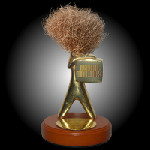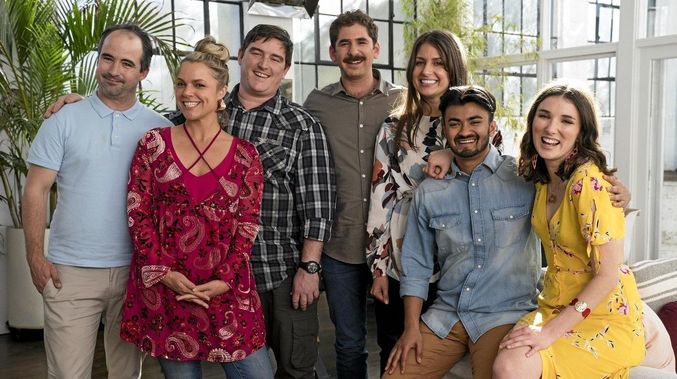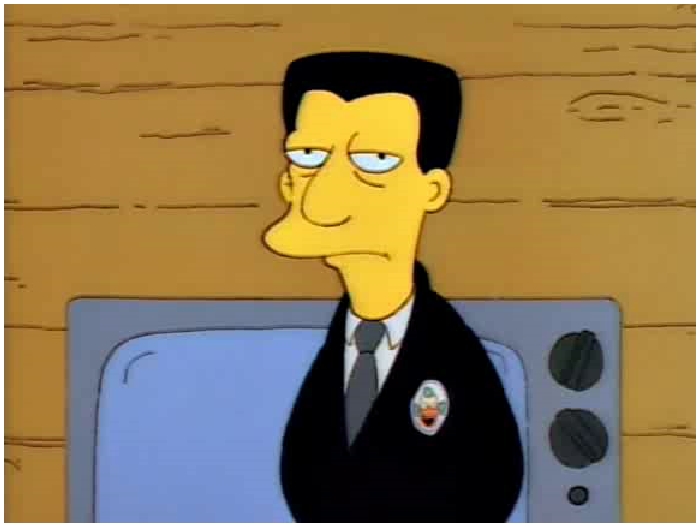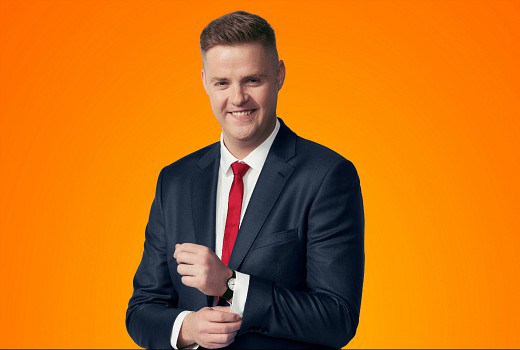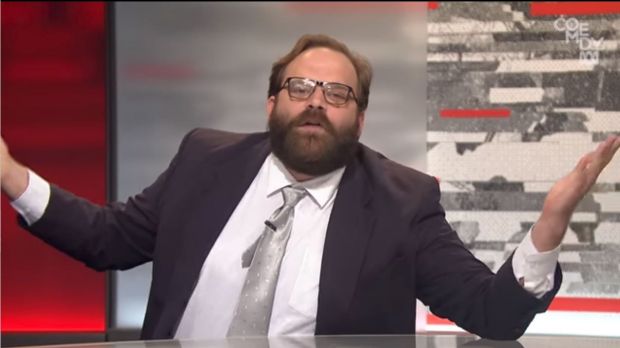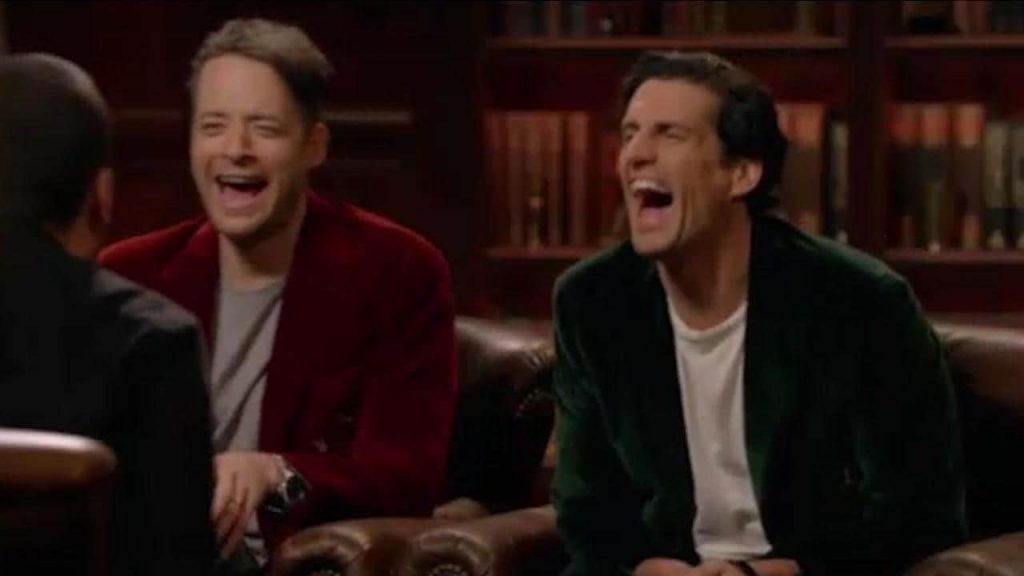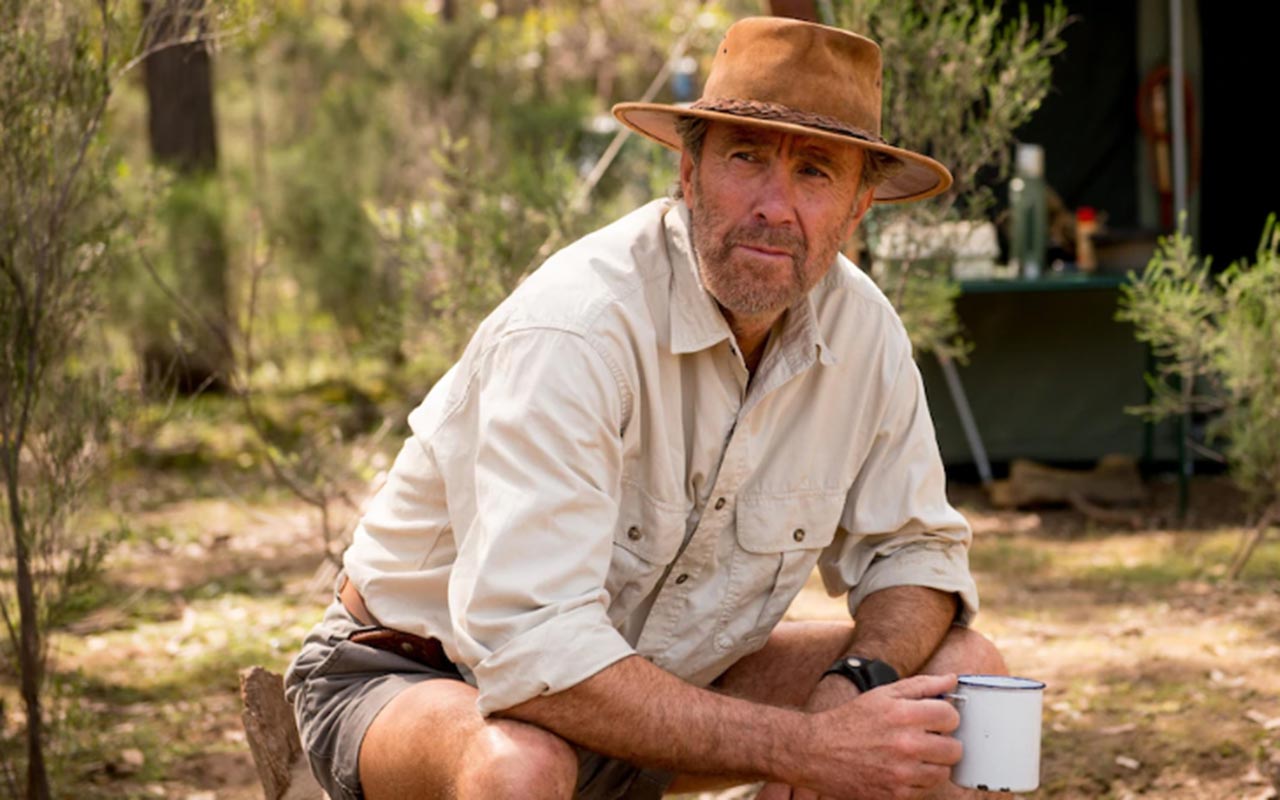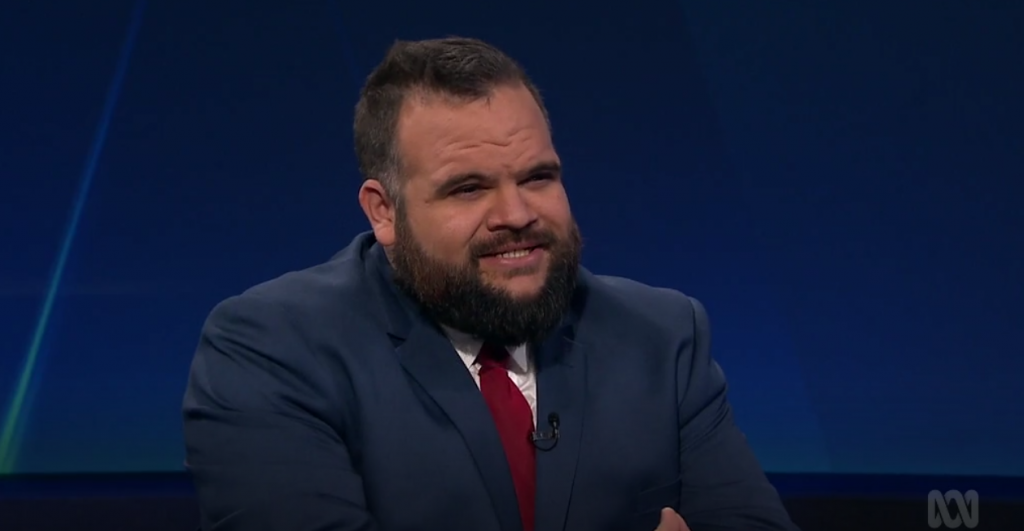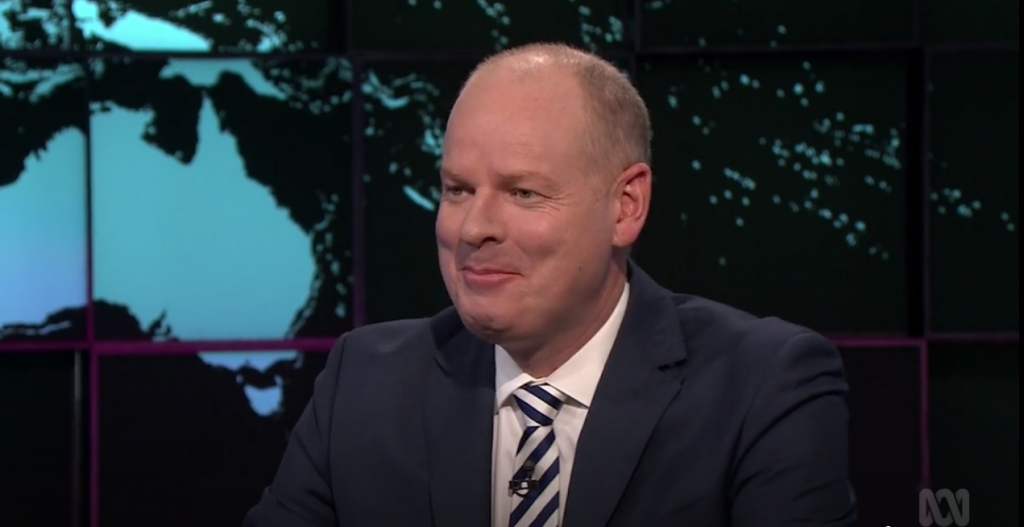Australian Tumbleweeds
Pilot Week day 1 – It’ll give you the skits
Ten’s Pilot Week started with the ensemble sketch show Skit Happens and Sam Dastiyari’s Disgrace, in which the ex-politician and a panel analyse gutter journalism. And while the latter was a Gruen-style peek behind a curtain we’ve looked behind a number of times under our own steam, thanks, and Dastiyari and panel didn’t tell us anything we didn’t already know, Skit Happens was…yeah, actually it was like every traditional sketch show this country’s produced for ages. So, if you were expecting innovative new ideas and exciting talent from Pilot Week’s opening salvo, er, forget it.
Yes, that was Heath Franklin as a skateboarding Matt Preston. Because it’s seemingly impossible to make a sketch show in this country without parodying a popular show or personality via the medium of a lame high concept. Which means that we not only got Skateboarding Matt Preston but also a parody of Love Island but with desperate, single women competing for the interest of a cute fluffy cat, and a look into the life of a guy who’s Waleed Aly’s stand-by*. Stand-by Waleed, in case you’re wondering, spends all of his time in a “break in case of fire”-style glass box, waiting to be needed. Presumably, the box will be broken open and he’ll have his chance to shine in the final episode of the first series that Skit Happens isn’t getting.
Speaking of which…there were recurring characters too, or, given that this was a pilot, characters clearly designed to recur whether audiences embraced them or not. Enter Juan, the hot(-ish) Spanish fridge mechanic who can fix fridges by dancing to some sexy Latin beats and whispering sweet love to the afflicted white good. Or the Aussie backpackers driving a Combi van around Europe who have no interest in actually seeing the countries they’re visiting. Sure, we’ve all met people like the backpackers, but we never want to again. So by television logic, if Skit Happens gets a series we will. Every goddam week.
(what’s the difference between a good sketch show and a shit one? The good sketch show has sketches based on funny ideas; the shit sketch show has sketches based on “funny” characters)
Oh, and why is it that every single sketch in this show (and almost every other Australian sketch show made in the past 20 years) seems to go on for ages despite it containing just one (or less) comic ideas? Has anyone in TV ever considered that if they picked up the pace and gave that one idea the runtime it deserves (30 seconds or less), these shows might not haemorrhage viewers until they’re axed at the end of series one?
There are lots of problems with Skit Happens and sketch shows like it (and we’ll go into more detail about this when we’ve fully digested the full force of Pilot Week), but the basic problem here – apart from that it’s not very funny – is that there’s no reason for it to exist, let alone for viewers to tune in. The show isn’t built around any kind of over-arching concept or hook, and the personnel don’t seem to have a rapport or have worked together much so they haven’t developed a theme or a shared vision for what this show’s about. They’ve just created some characters and written some sketches and these are the least worst of them. Enjoy! Or not. Mostly not.
As for Disgrace… yeah, we’ve been there, done that, and it was hosted by Lawrence Mooney. But Unlike Dirty Laundry Live, this… actually, what did it do that was different from Dirty Laundry Live? Well, the entire panel was markedly less funny for starters. But surprisingly, they weren’t the usual faces, which gave it a couple points for novelty. And it desperately needed them, because a panel show discussing celebrity news is roughly 40% of Australian television once you factor in breakfast and morning shows and this did absolutely nothing to separate itself from the pack.
So yeah, this one’ll probably go to series. Just don’t expect us to tune in ever again.
* Just how bad was Skit Happens? We didn’t even laugh at the joke about Charlie Pickering’s shit-eating grin.
Now here’s… “Mr Black”
Sadly no, not this guy:
Here’s the scoop:
Stephen Curry is playing the curmudgeonly lead character who moves in with his daughter and her boyfriend in Mr. Black, a sitcom commissioned by Network Ten.
Created by Adam Zwar (Squinters, Wilfred, Agony) and co-written with Amanda Brotchie (Squinters, Lowdown), the eight-part series is being produced by CJZ and directed by Brotchie and Clayton Jacobson.
Nadine Garner (The Doctor Blake Mysteries, City Homicide) is Mr. Black’s estranged wife Rowena with Sophie Wright (Kinky Boots) as their daughter Angela and Nick Russell (Winners & Losers) as her sensitive, new-age boyfriend Fin. The other series regular is Paul Denny (Lowdown) as a character named Malcolm.
CJZ MD Nick Murray tells IF the idea for the sitcom came up while Zwar was developing another project with CJZ’s head of entertainment and comedy Damian Davis. The CJZ creatives loved the concept of the lead, a former sports journalist who insists on being called Mr. Black, being forced to move in with his daughter and her boyfriend due to ill health. Much of the humour turns on the fact that Mr. Black despises Fin and does all he can to try to break up the relationship.
Ten’s head of comedy Paul Leadon said: “It is a delight to be working with Adam and Amanda. They are an incredibly strong creative duo. Throw in Stephen Curry, Nadine Garner, an amazing cast, plus the team at CJZ and we have all the ingredients for a very special narrative comedy.”
Screen Australia and Film Victoria are investors in the production which is shooting in Melbourne.
The best part of these stories is always the origin of the idea, because while they don’t actually come out and say “we were laughing at this bit from The Simpsons and thought ‘lets do a show about this guy'” –
– we all know that’s pretty much what happened.
Because what’s the alternative? That Australia’s top comedy creatives “loved the concept” of a “very special narrative comedy” based around a “curmudgeonly lead character” making life hell for his more progressive offspring and her “sensitive, new-age boyfriend”?
You know, like Kingswood Country. A lot like Kingswood Country.
At least with our origin story they’re starting out with a show that was funny.
Dan Ilic’s Death Touch
Remember Tonightly?
Yeah, it’s been axed:
The ABC will not renew Tonightly with Tom Ballard beyond its final airing on 7 September. Attracting younger audiences requires bold approaches and we continually experiment with new content and new formats particularly on digital platforms. We remain committed to exploring and developing projects that connect with different demographics.
Tonightly deliberately pushed boundaries to inform and entertain. We are proud of the program and its role in supporting some of Australia’s best emerging comedy talent. Our thanks go to the very talented team members for their hard work and dedication in producing a complex and cracking show in quick time, over some 150 episodes. We look forward to working with them again in the future. A special thanks to Tom for helping us to laugh, cry and sigh about the world.
It is now time for a fresh approach. The ABC will continue to develop innovative content on broadcast TV and digital services, through comedies such as Back in Very Small Business and Get Krack!n’, and live shows such as the Splendour in the Grass TV special on Rage and the upcoming triple j One Night Stand and One Night Stand Up on ABC TV and iview.
Tom Ballard said: “Getting the chance to host Tonightly has been an absolute honour and privilege, even though we never got to be on Media Watch. I feel so proud of the ‘work’ we made and I feel so lucky to have been surrounded by laughter and stupidity for an entire year. My sincere thanks go to the brilliant Tonightly team, the ABC and the fans of Cory Bernardi.”
Whether you liked the show or not – on the whole we did, though it had its problems – this is shit news with no winners. Well, maybe The Weekly, as now a show made on a fraction of the budget and with a fraction of the time will no longer be twice as funny as it.
But c’mon, take a look at the “fresh approach” the ABC is peddling in their very own press release: the return of Very Small Business – which is great but was last seen back in 2008 – and a bunch of music specials promoting a radio station. You’d think Tonightly was an embarrassing failure being axed two weeks in rather than one of the ABC’s rare long-running comedy success stories – and even then touting these shows as a “fresh approach” is an admission that there is clearly nothing fresh about the ABC’s youth programming.
As for exactly why Tonightly has been axed… well, the whole ABC Comedy channel project must be under a pretty heavy cloud if literally the only local content made for it is getting the boot. As a local program made for a minor channel its survival was always going to be iffy; as an Australian comedy program made without overseas money its budget was always going to be marginal. And at the ABC, axing popular (or even just “popular”) youth programming in its prime is pretty much a tradition; bringing in the kids might be one of their goals, but you don’t see a whole lot of youth at management level. So maybe getting a full year was all we were ever going to get of Tonightly.
Or maybe it’s because the host had been under a cloud after indecent assault allegations and a recent sketch had gone out of its way to offend the kind of uptight people currently running the country. Hey, you just can’t help bad luck.
Is it OK to swear in comedy?
Remember that story six months ago about that Tonightly sketch that upset the Minister for Communications Mitch Fifield, Cory Bernardi and various others, and inspired several complaints to ACMA and the ABC? Well, late last week, ACMA cleared the show:
Today ACMA has found no breach by the ABC, noting the comedic context rather than being used for attack…
…Key to the ACMA’s finding was the target audience’s likely familiarity with the comedic style of the program, and its broadcast at 9pm with an MA15+ classification which allows for coarse language.
This was the sketch in question…
…or, if you can’t be bothered to watch it, here’s how TV Tonight summarised it…
The ABC is under fire from the Minister for Communications Mitch Fifield after Tonightly with Tom Ballard showed a poster of an Australian Conservatives candidate with the wording “is a c**t.”
The joke from comedian Greg Larsen suggested the electorate of Batman be renamed “Batman is a c**t” due to founder John Batman’s links to the murder of Aboriginal people.
“We cannot shy away from the terrible things he did,” Larsen suggested.
Elaborating on his idea, to feigned objections from Ballard, Larsen showed mock posters of Greens candidate Alex Bhathal & Labor candidate Ged Kearney with the words “Batman is a c**t.”
But for Australian Conservatives candidate Kevin Bailey he noted, “This was an issue because there is no Batman anywhere on that poster, so I’ve had to put ‘Kevin Bailey was a c**t’,” Larsen said.
“Greg that is unacceptable; regardless of what you think of his politics that is completely beyond the ball!” Ballard replied.
Mitch Fifield said in a statement, “Candidates for elected office expect to be criticised and parodied. But this ABC segment clearly crossed a line, particularly given that it was directed towards an individual who has served his nation in uniform.
“Vitriolic abuse of this kind has no place on the national broadcaster and I will be asking the ABC to investigate. The ABC should also immediately offer an unreserved apology to Mr Bailey.”
Australian Conservatives leader Cory Bernardi has also reportedly written to ABC managing director Michelle Guthrie to complain.
…so, now that you’ve either watched the video or read the above summary, or both, do you think Tonightly crossed the line? Because we don’t. In fact, it was obvious at the time that it hadn’t, and that this was a beat-up by a bunch of right-wingers deliberately misunderstanding the sketch and piling-on it as a way to attack the ABC.
The joke wasn’t calling Australian Conservatives candidate Kevin Bailey a cunt, it was about calling John Batman a cunt. Context in comedy is extremely important and its good to see ACMA make a context-based ruling in this instance, even if, as ACMA pointed out in their ruling “the limits [of the context] were certainly tested by the program”.
Of course, whether the sketch was funny and a good piece of satire is another matter. Arguably, if you have to resort to calling someone a cunt – whether they’re a historical figure or a current aspiring politician – you’ve lost the argument. In this podcast (which is well worth your time) Shaun Micallef argues that swearing is something you should minimise in comedy, for a few very good reasons:
I’m protective of the power of those particular words…you want to keep your powder dry with those ones because they’re helpful words, beautiful words in the English language that still have enormous power, so you want to save them…my general rule is that if you can do without it then you do…if the end line of a joke is a swear word, and you take it out and there’s nothing there, then it’s probably not a very good joke.
Although it’s probably also true to say that this particular Tonightly sketch would have been less hard-hitting had it gone with a softer take like “Batman was a bastard” or a slightly more accurate term like “Batman was a genocidaire”.
… partly because almost no one’s heard of the term “genocidaire”.
True Dinks take 2
The not-so-surprise comedy success story of 2017, True Story with Hamish and Andy is back and operating on an equally unsurprising principle: if it ain’t broke, don’t fix it.
So the set-up remains exactly the same: Hamish & Andy sit on a couch, a regular unknown person sits down across from them and proceeds to tell a classic story from their life that will – hopefully – entertain and amuse. It’s Drunk History without the booze or the learning, but with a fairly polished story that usually provides some laughs.
“It was a long time ago, and I was very young” is a great way to distance yourself from your bad behaviour. And so it proves to be in episode one, as a tale of trying to get out of poetry homework (having to come up with 24 poems is pretty steep, admittedly) in 1986 rapidly escalates thanks to one slack student’s refusal to admit her sickie is fake. Do we end up in a hospital heading for surgery? It’d be a short episode if we didn’t.
While all the old favourites are back, and by that we mean decent comedy performers in cameo roles – hey look, Rob Sitch as a rhyming poetry teacher! Mark Mitchell hamming it up as a doctor! Stephen Curry as a surgeon! – there’s a new twist or two as well. Having the re-creation change as the story-teller provides more or new information is an obvious way to get laughs and starting out the first episode with an example (our lead in the flashback changes as we’re told more about her look) suggests things might be a bit more flexible reality-wise this season.
(okay, we saw Hamish & Andy on breakfast television and they said there’s an episode coming up where the storyteller is a bit of a bullshitter and they constantly had to rein him in)
But otherwise this remains the kind of solid, unremarkable amusement that Australian television really needs to consider as the floor for broadcast quality rather than a high water mark. Hamish & Andy can get stories out of the public in their sleep after over a decade in radio, the stories themselves are good but rarely great (hey, at least they don’t have to pay writers for the ideas) and while the all-star casts are great the actors rarely get to do much more than turn up and get a recognition laugh or two.
The core problem is that this is a show that says that while craft and care should be lavished on every other aspect of the production – the production values are always first-class (just look at the range of locations!) – comedy itself can’t be crafted: you just ask random people for funny stories and use the best. And again, while these stories are good, we’re not talking about a halfway decent episode of The Games or Frontline here; given a fortnight pretty much anyone reading this could come up with a much funnier “real-life” story*, but that would defeat the purpose of the show. Which, following that line of logic, clearly isn’t to be funny.
Put another way, television comedy lives or dies in the writing, and this show doesn’t really want to use writers at all.
*anyone who says “you couldn’t make this stuff up!” deserves a slap. It’s the story of a teen girl who refused to admit her illness was faked, not Fawlty Towers.
Ow, that (Street) Smarts
Australian comedy isn’t exactly known for exceeding expectations. But with Street Smart – the new sitcom from the makers of Here Come the Habibs, with a fair spray of Fat Pizza and Housos DNA in there – it’s not like they could really do worse. These are shows where even the fans are laughing at them at least as much as with them, and even those laughs are becoming harder to find.
So here’s the good news: this time around, Tahir Bilgic and his crime crew are focusing on what they do best – not telling jokes. Or at least, not making a show that’s built entirely around telling jokes, and we can all be somewhat grateful for that.
The set-up of Street Smart is that four idiots want to commit crimes. But where most Australian sitcoms would then dig down into a bunch of barely amusing character stuff about each of them, recycling the same situations over and over again each week, Street Smart tries something different: the focus is on the caper.
Upon discovering that the local cop shop has a room full of confiscated items, the gang come up with a scheme to get inside, and… look, the whole thing ends with them stripping, then getting robbed in their underwear so don’t get your hopes up. And yes – *heavy sigh* – there is also a bunch of character stuff as well and it’s about as funny as you’d expect: men are stupid, women are pushy and also stupid. At least everyone’s a cartoon so no-one can get too offended.
But by putting at least some of the focus on their criminal scheme, there’s an element of “how’s this going to play out?” that makes this just that little bit more interesting to watch than you might think. It’s been a while since Australia made a sitcom with this much story; usually we’re happy with an ironic ending that makes it feel like everything we just saw was somehow linked. And while it’s not a great story, it does feature a string of events that flow semi-logically one after another to end with a character trapped in a prison cell talking to the toilet.
Look, let’s not get too excited here: almost all of these jokes are bad, the plotting isn’t exactly Ocean’s 11 level and the one big twist was just recently done in the now-showing New Zealand comedy movie The Breaker Upperers (which is well worth your time). But the combination of a halfway decent story and a whole lot of jokes – some of which do work: the fake cop outfits were funny, and “Trans Phats” is a halfway decent pun – means this is slightly less painful to watch than 80% of Here Comes the Habibs.
Then again, it seems Ten have decided that “Crappy Shows Don’t Work Anymore“, so this probably won’t be back next week.
All Aussie Adventures: Hittin’ the road again
The return of All Aussie Adventures last night comes at a time in TV history when broadcasters seem to be increasingly looking to the popular favourites of the past to draw in an audience (Roseanne, that proposed re-boot of Hypotheticals, that proposed re-boot of Frasier). Which is all well and good if it’s entertaining and funny, but maybe less so if you have no idea of the context of the show.
The first series of All Aussie Adventures, starring Glenn Robbins as Russell Coight, was broadcast so long ago that it pre-dates 9/11 (by two days). Even then, it was parodying a genre of television which had largely faded from our screens – The Leyland Brothers, Malcolm Douglas, Steve Irwin, and Les Hiddens in The Bush Tucker Man – in which one or more wizened blokes did it rough in the outback, drawing on the knowledge of the first Australians and their own wits to survive.
Anyone under 35 probably remembers Steve Irwin but most likely not Malcolm Douglas, Les Hiddens, or Mike and Mal Leyland. Not for them a childhood of watching in awe as Les discovers food and water in a seemingly barren landscape, or the Leylands find themselves stranded in the desert with little in the way of supplies and no way of getting help.
But this probably doesn’t matter when it comes to All Aussie Adventures. The main gag is that Coight, for all his soliloquies to camera about good bushcraft, actually has very little knowledge of outback survival at all – which makes watching him stuff it up all the more hilarious.
Most people love a good “hit in the nuts” gag, and there are at least three good ones in the first episode of All Aussie Adventures. There are also plenty of other gags of a similar nature, in which Coight falls, stumbles or generally makes life worse for himself and anyone who happens to be passing.
Working Dog, the makers of this show (and also of Have You Been Paying Attention?), are well-known for their high gag rate, and All Aussie Adventures doesn’t disappoint. Even if you think you know where the gag is going – and the set-up isn’t always subtle – it’s always either brilliantly performed by Robbins or goes somewhere slightly different to your expectations, so almost all of the gags land perfectly. Not something you can say of the show which followed it, Street Smart. But more on that some other time…
The Notorious B.R… iggs.
It’s been a while since we checked in on The Weekly, which probably makes us a regular cast member because hey look, Briggs is back! For only the second time this year. Remember when they announced he was going to be a regular cast member and then he promptly vanished from the line-up? Good times.
Good to see the warm, hilarious banter between Briggs and Charlie “I have a black friend, honest” Pickering is still there though: “The last time you were here you went for a ride with Bill Shorten on a bicycle built for… I want to say one-and-a-half”. No Charlie, what you want to say is the last time Briggs was here was back in episode one and we’re now up to episode 14: he’s appeared on the show less times than the Channel Nine logo in the corner of all that footage you’re constantly lifting from the commercial networks, and yet he’s still in the opening credits each week. Why?
Then again, maybe it’s just that nobody wants to sit near Pickering: Kitty Flanagan was nowhere to be seen this episode either – and it wasn’t like they didn’t have room, as Mel Buttle was on basically doing Kitty’s segment – while the only other regular cast member Tom Gleeson… well, of course he was there front and center:
That’s the face of a man just happy to be anywhere.
Otherwise… well, what else is there to say about a show that even the ABC’s own iView page doesn’t know whether to list under news, comedy, or a complete waste of time? It’s still 25% news clips from other shows, a forgettable interview segment, a forgettable interview segment hosted by Charlie Pickering, an OTT comedy rant delivered by Flanagan 80% of the time and a general sense of being made by people with one eye on the clock. It is what it is.
This idea of having Briggs do the “hard hitting” political interviews (this episode: Adam Bandt) is a bit strange though. It’s not like Pickering couldn’t do them and it’s not like Briggs is a great interviewer – or even a regular on the show – so why bring him in just for them? If they can only get him on as an occasional guest but they want to make his appearances seem special, why get him to do the one thing everyone else on the show is already doing every week?
Having Briggs do the political interviews on a show where the two main regulars are already doing interviews really just underlines how shithouse the two main regulars are. They’re both interviewers on what is just a soft news program, but you can’t get Gleeson to interview politicians because he’s a sarcastic shit, and you can’t get Pickering to interview politicians because… why again?
The only reason we can think of that makes sense from the show’s point of view – he’s the host; even just for promotional reasons you’d want him to be the one doing the high profile, big-deal chats – is that they don’t want Pickering sucking up to politicians so he can remain unbiased when it comes time for him to do his trademark hard-hitting political commentary and close-to-the-edge satire.
And if that’s the case, it’s funnier than anything The Weekly has put to air in a very long time.
True Dinks
Press release time!
True Story with Hamish & Andy, the breakout smash hit from 2017, returns for its eagerly awaited second series on Tuesday, August 7, at 8.40pm on Nine and 9Now.
This original format brings to life the best Australian tales you’ve never heard, told by the very people who experienced them and then humorously and cinematically realised through dramatic recreations.
In each half-hour episode, Hamish and Andy meet one regular Australian storyteller who recounts their amazing, surprising, funny and above all true story, which is simultaneously recreated by a cast of Australia’s most renowned performers.
The carefully scripted recreations produce a dramatic and heightened reality that brings a sense of the epic to these everyday stories of glory … or perhaps more often than not, complete humiliation.
The first series was a ratings smash hit, acclaimed by critics and viewers alike. Each episode attracted an average audience of almost two million viewers (including encore screenings and streaming on 9Now), making True Story with Hamish & Andy one of the most successful new program launches in recent years.
An all-star lineup of actors has been assembled for series two including Essie Davis, John Waters, Dan Wyllie, Bruce Spence, Rob Carlton, Rob Sitch, Mark Mitchell, Jane Allsop, Stephen Hall, Dave Lawson, Anne Edmonds, Katrina Milosevic, Georgia Love, Sam Pang, Susie Youssef, Debra Lawrance, Richard Davies, Brian Mannix, Shareena Clanton, Kate Jenkinson, Jessica Tovey, Ian Meadows, Denise Scott, Michala Banas, Toby Truslove, Santo Cilauro, Nicholas Bell, Dilruk Jayasinha, Kate McCartney, Luke McGregor, Mandy McElhinney, Dave Hughes, Christie Whelan-Browne and Genevieve Morris.
In Episode One we meet Carol. Despite Carol’s visual impairment, her mum has always told her that she can do anything. In 1986, when Carol was 15, she was given an English assignment that required her to write out and analyse 40 poems. But the night before the due date, she hadn’t even started. And with reading not her strong suit, Carol decided that her only way out was to fake an illness and miss the next day of school. What we learn in this amazing True Story is that once Carol is committed to something, there is no going back – even if what she has committed to is entirely fictitious. Will the highly trained medical fraternity catch Carol out, or will the wily teenager fool them all, just to get out of an English assignment?
True Story with Hamish & Andy, made with the assistance of Film Victoria, is created and produced by Tim Bartley, Hamish Blake, Andy Lee and Ryan Shelton, and written by Hamish Blake, Andy Lee and Ryan Shelton.
Guess we all knew this was coming, but it doesn’t hurt to having it down in writing. Especially as they don’t seem to be flogging it quite as hard second time around; sure, we’ve seen some ads, but compared to the return of Russell Coight’s All Aussie Adventures – which you’d have to be in the grave to no know is back this Sunday evening – it’s definitely flying in under the radar.
So here’s to our favourite not-quite Drunk History series: the cast may not be quite as high-powered as the first season, but presumably this time around they have a been idea of what works so the stories themselves will get the job done. And if no, they can always bring back the crime kid from season one: presumably his scams only got more advanced once he made it to high school.
